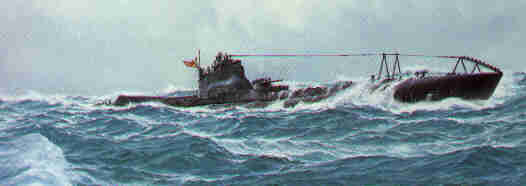SENSUIKAN!

HIJMS Submarine I-73: Tabular Record of
Movement
© 2001 Bob Hackett & Sander Kingsepp
Revision 1
7 January 1937:
The I-73 is completed at the Kawasaki Shipbuilding Yard, Kobe, commissioned in the IJN and based in the Kure Naval District.
11 November 1941: Operation Z:
The I-73 is in Vice Admiral Shimizu Mitsumi's (former CO of ISE) Advance Expeditionary Force (Sixth Fleet) with Rear Admiral (later Vice Admiral) Miwa Shigeyoshi's (former CO of KINU) SubRon 3 in Captain Otake Toshio's Sub Div 20 with the I-71 and the I-72. Cdr Isobe Akira is the I-73's Commanding Officer.
Admiral Shimizu convenes a meeting of all his commanders aboard his flagship, the light cruiser KATORI. LtCdr Ichikawa and the other commanders are briefed on the planned attack on Pearl Harbor. The I-73 departs Saeki with the I-68, -69, -70, -71 and the I-72.
20 November 1941:
Arrives at Kwajalein.
23 November 1941:
Departs Kwajalein for Hawaii on her first war patrol with ComSubDiv 20, Captain Otake embarked.
2 December 1941:
The coded signal "Niitakayama nobore (Climb Mt. Niitaka) 1208" is received from the Combined Fleet. It signifies that hostilities will commence on 8 December (Japan time).*
5 December 1941:
The I-73 reconnoiters the Kealaikahiki Channel between Maui, Kahoolawe and Lanai. Later, the I-73 and the I-71 reconnoiter the Lahaina
anchorage.
7 December 1941: The Attack on Pearl Harbor:
SubRon 3 is deployed south of Oahu. Its mission is to reconnoiter and attack any ships that try to sortie from Pearl Harbor. The I-73 is positioned off the entrance to Pearl Harbor.
23 December 1941:
The I-73 fires six shells at Johnston Island. One knocks down the CAA homing tower at Sand Islet and wounds a Marine. The I-73 later reports that a telegraph pole was hit. The garrison fires twenty 5-inch rounds in return and the I-73 dives.
29 December 1941:
Arrives at Kwajalein.
12 January 1942:
Departs Kwajalein with the I-71 and the I-72 on her second war patrol to relieve the I-18, -22 and the I-24 that formed a picket line in the Hawaii area. Captain Otake is again embarked aboard the I-73.
15 January 1942:
Cdr Isobe sends a situation report from his assigned area.** It is the last message received from the I-73.
27 January 1942:
240 miles W of Midway. LtCdr (later Vice Admiral) Elton W. Grenfell's USS GUDGEON (SS-211) is returning to Pearl Harbor from her first war patrol to the Bungo Straits off Japan. Grenfell receives an "Ultra" message advising of the approach of three Japanese submarines (I-18, I-22 and the I-24).**
The I-73 is enroute back to Yokosuka. Her propeller sounds are picked up by sonar off the GUDGEON's port bow. Grenfell, running submerged, spots the submarine and begins his attack. The I-73, with many of her crewmen on deck, is running a straight course and not zigzagging. Grenfell fires three Mark 14 steam torpedoes from 1,800 yards and scores two hits***. The I-73 sinks with all hands at 28-24N, 178-35E. She is the first warship ever sunk by an American submarine.
27 January 1942:
Presumed lost off Hawaii. Captain Otake is promoted Rear Admiral, posthumously and Cdr Isobe is promoted Captain, posthumously.
15 March 1942:
Removed from the Navy List.
Authors' Notes:
*Mt. Niitaka, located in Formosa (now Taiwan), is then the highest point in the Japanese Empire.
**Japanese sources suggest that the I-73's report was not picked up by the codebreakers. The I-18, -22 and the I-24 were returning after shelling Midway. The I-73 was sunk "mistakenly" instead of the I-24.
**Post-attack analysis by the ComSubPac staff at Pearl indicates that the GUDGEON's unreliable Mark 14 torpedoes may have been duds. The theory holds that the I-73's crew spotted the wakes of the incoming torpedoes, panicked and dove with either their main induction valve or a hatch open, never to resurface.
Special thanks for help in preparing this TROM go to Dr. Higuchi Tatsuhiro of Japan. – Bob
Hackett and Sander Kingsepp.
Back to Submarine
Page





